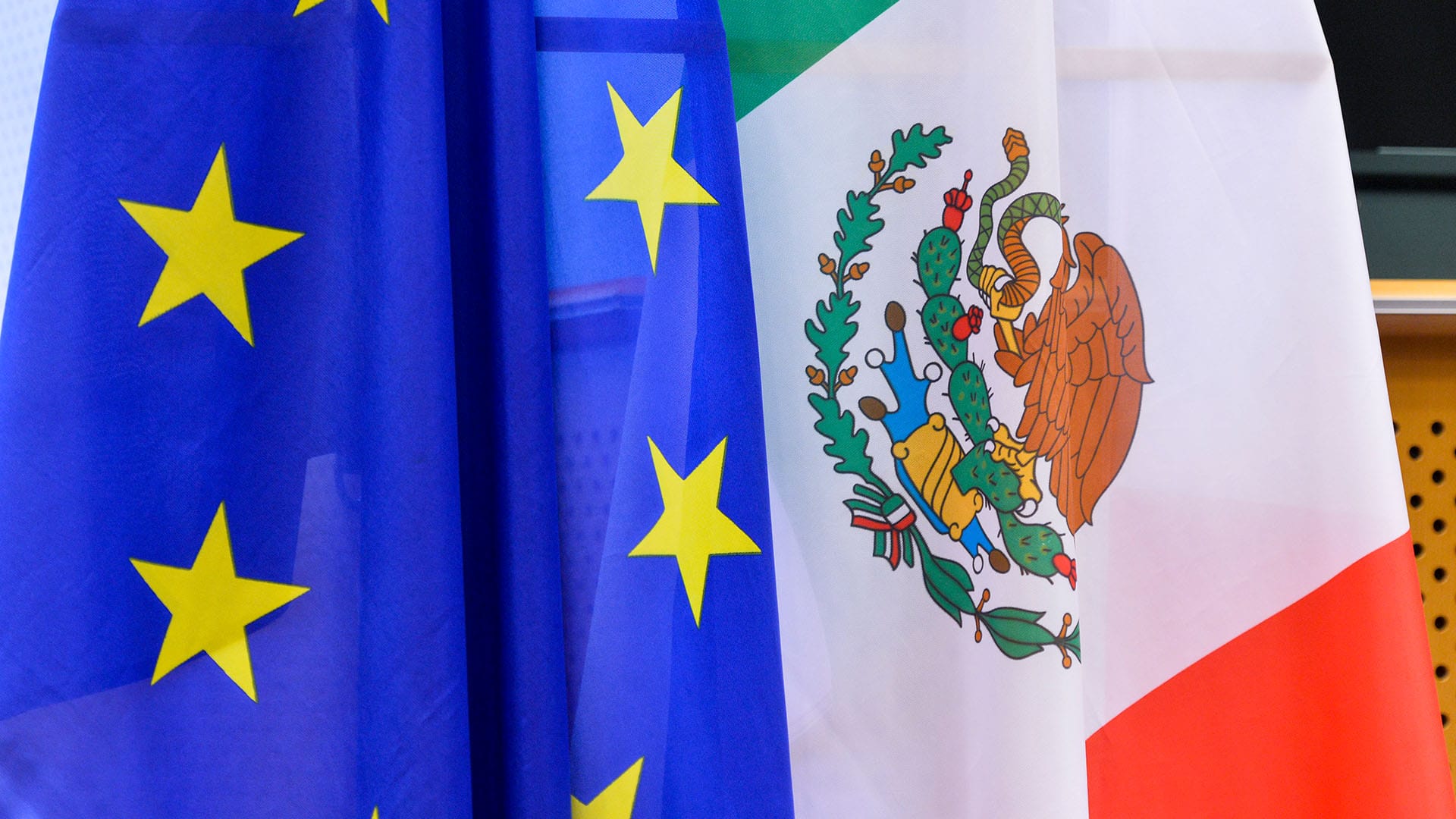Theme
These are the questions about the modernisation of the EU-Mexico Global Agreement: what is it about; what does it imply; and what will be its impact on the dynamics of bi-regional integration between the EU and Latin America.
Summary
Mexico and the EU consolidate their strategic association with a modernised agreement that expands economic opportunities. The renewal of the EU-Mexico FTA updates an agreement that has been in place since 2000, eliminating restrictions in key sectors such as agri-food, services and public procurement, in addition to incorporating regulations on digital trade and data protection.
The EU accelerates its integration with Latin America & the Caribbean (LAC) in response to the geopolitical reconfiguration and the uncertainty and risks of a second Donald Trump presidency. In the last 13 months the EU has modernised key agreements with Mexico and Chile, and finalised the agreement with Mercosur, seeking to strengthen its presence in the region and diversify its alliances in the face of US unilateralism and protectionism and the growing influence of China.
These agreements not only eliminate trade barriers, but also establish a common regulatory framework based on shared values. Beyond reducing tariffs, the new agreements harmonise regulations, protect investments, facilitate dispute settlement and reinforce commitments to sustainable development, human rights and the rule of law.
The EU seeks to reduce its dependence on China and Russia by securing supplies of strategic raw materials for the green transition. LAC emerges as a key partner in the provision of resources such as lithium, copper and platinum, and for the establishment of decarbonised value chains and renewable energy.
For LAC, the EU emerges as a large and sophisticated third market, complementing existing trade opportunities and allowing LAC countries to integrate into high value-added value chains and diversify their economic relations, thus reducing their dependence on the two main global powers, the US and China.
The next key step should be the interoperability and regulatory convergence among the network of trade agreements between the EU and Latin America (covering 95% of the GDP of Latin America and the Caribbean) to transform the architecture of EU-LAC trade and Latin American intraregional trade. Moving in this direction would create an integrated EU-LAC economic space of 1.1 billion people with a GDP comparable to that of the US and EU-LAC bilateral trade would increase by up to 70%, while LAC intra-regional trade would grow by up to 38%.
Analysis
Just a few weeks after the announcement of the EU-Mercosur agreement in Montevideo, Uruguay, last 6 December, following 25 years of discussions, the EU took a new step in its integration strategy with Latin America by closing after nine years of negotiations the modernisation of the EU-Mexico agreement (EU-Mexico FTA), updating the treaty in force since 2000. The agreements follow the modernisation of the EU-Chile agreement, concluded in December 2023 and ratified by the European Parliament in February 2024.
The accelerated pace at which these agreements are being concluded is by no means a coincidence, but a clear manifestation of the EU’s political decision to strengthen its strategic partnership with Latin America in a context of global geopolitical reconfiguration and the uncertainties and risks of a new Trump Administration in the US.
Unlike conventional trade agreements, which focus on reducing barriers to trade, these next-generation pacts go much further: they harmonise regulatory frameworks, protect investment, establish streamlined dispute settlement mechanisms, and reflect a shared vision of sustainable development, human rights and democratic values and the rule of law. In the words of the President of the European Commission, Ursula von der Leyen, ‘This landmark deal proves that open, rules-based trade can deliver for our prosperity and economic security, as well as climate action and sustainable development’.
The EU saw the geostrategic opportunity and is embracing it. Its recent agreements with Mercosur, Mexico and Chile reflect a bid to diversify its alliances in the face of the US protectionist threat, to secure a reliable and sustainable supply of strategic raw materials for the green transition (lithium, copper, platinum, etc) and reduce dependence on China and Russia, and to facilitate the development of decarbonised and renewable energy value chains with a region rich in clean, abundant and cheap energy.
If the EU-Mercosur agreement is ratified, the EU would become the global power with the largest presence and deepest ties in the region: the EU would have agreements with all LAC countries (except Cuba and Venezuela) covering 95% of the LAC’s GDP, compared with 44% for the US and 14% for China (see Figure 1), countries that have not even started negotiations with Mercosur.[1]
Figure 1. LAC Trade Agreements with the EU, US and China
| Partner country | Type | Year | Status | % GDP of LAC | |
|---|---|---|---|---|---|
| Mexico | EPA | 2000* | Under ratification | ||
| Chile | EPA | 2002* | In Force | ||
| CARIFORUM | EA | 2008 | In Force | ||
| EU | Central America | AA | 2012 | In Force | 95 |
| Colombia | FTA | 2013 | In Force | ||
| Ecuador | FTA | 2013 | In Force | ||
| Peru | FTA | 2013 | In Force | ||
| MERCOSUR | AA | 2024 | Under ratification | ||
| Chile | FTA | 2004 | In Force | ||
| CAFTA-DR | FTA | 2004 | In Force | ||
| US | Peru | TPA | 2009 | In Force | 44 |
| Colombia | TPA | 2012 | In Force | ||
| Panama | FTA | 2012 | In Force | ||
| US-Mexico-Canada | FTA | 2018 | In Force | ||
| Chile | FTA | 2005 | In Force | ||
| Peru | FTA | 2009 | In Force | ||
| China | Costa Rica | FTA | 2011 | In Force | 14 |
| Ecuador | FTA | 2024 | In Force | ||
| Nicaragua | FTA | 2024 | In Force |
The EU is thus positioning itself not only as Latin America’s most important strategic partner, but in a world where the rivalry between the US and China has turned trade and investment into a battlefield, it seeks to position itself as a reliable partner, offering stability and clear rules.
1. The EU and Mexico renew vows: a leap into the future
Mexico and the EU have had a strategic relationship for decades, although it sometimes seems that this closeness is overshadowed by the ties of both regions with the US. The current agreement between Mexico and the EU dates back to 2000, and since then it has produced important results –trade is around €85 billion and €20 billion in services– but they are certainly still below potential.
The original agreement between Mexico and the EU was at the time a historic milestone, for several reasons: first, it was the first EU trade agreement in Latin America, while for Mexico it was the first agreement outside the American continent. Additionally, the agreement not only allowed for the elimination of tariff barriers in key sectors, but also established a framework for political cooperation, something that Mexico has not repeated with any other partner so far.
It is undeniable that over the past two decades the relationship between Mexico and the EU has strengthened significantly. Mexico’s main European partners –Spain, Germany and France– have contributed significantly to this close relationship. Spain has established itself as one of the largest European investors in sectors such as telecommunications, banking and energy, fostering an economic link that is also supported by deep historical and cultural ties. Germany, for its part, has been key in the transformation of the Mexican manufacturing industry, particularly in the automotive sector, where many German companies have found in Mexico an ideal platform to access the North American market under the framework. France has also increased its presence in sectors such as aerospace, pharmaceuticals and renewable energies, reaffirming the strategic nature of this relationship.
However, like any instrument, the scope of the first version of the EU-Mexico FTA reflected the priorities of the time, so it did not consider areas that are fundamental today, such as digital trade, data protection and a more advanced approach to sustainability. Additionally, it is important to note that the original agreement was signed before the entry into force of the Lisbon Treaty in 2009, when the EU’s trade competences had a different scope. This context also underscores the relevance of modernisation, which not only adapts the trade disciplines to the challenges of the 21st century but also aligns the agreement with a more integrated and sophisticated institutional framework in the EU.
In addition, both Mexico and the EU subsequently negotiated agreements with other countries and regions of the world, which gradually superseded the conditions applicable to their bilateral trade. Significantly, the original EU-Mexico FTA did not eliminate tariffs on agricultural trade, leaving a number of products at a disadvantage vis-à-vis Mexico and the EU’’s trade with other partners.
Therefore, in 2016 Mexico and the EU initiated a lengthy process of negotiations seeking to modernise the agreement. This effort culminated in 2018 with a result ‘in principle’ (ie, subject to legal review, minor changes and the final signing of the agreement), which included advanced disciplines and the incorporation of areas that had not been contemplated in the original treaty.
Among the new developments, the following stand out:
- The opening of agricultural markets: existing tariff barriers were eliminated, particularly in agri-food products, offering new opportunities for exporters from both regions.
- The liberalisation of the services sector: new opportunities were opened up for companies from both regions in key sectors such as telecommunications, financial services and transport, promoting greater competitiveness and innovation.
- Public procurement: for the first time European companies will be able to participate in state-level tenders in Mexico, increasing competition and transparency. Mexico has not granted this benefit to any other trading partner.
- The protection of geographical indications: mutual recognition of emblematic products, such as cheese and wines, was expanded, strengthening local industries.
Despite concluding negotiations, the signing and ratification of the modernised agreement had been delayed by other issues. The administration of President Andrés Manuel López Obrador (2018-2024) focused primarily on navigating a complicated relationship with the US under the presidency of Donald Trump and the first year was entirely dedicated to concluding and ratifying the new agreement with the US and Canada (USMCA). By 2020, the emergence of COVID-19 virtually displaced all non-health-related issues. On the other hand, in Europe, COVID-19 and the war in Ukraine reconfigured the EU’s priorities.
Finally, the new geopolitical reality took over. Donald Trump’s return to the White House poses a challenging geopolitical dynamic for Mexico and the EU. Faced with the highly likely tightening of US trade and migration policies, it is more important than ever for Mexico to diversify markets and strengthen alliances with other economic blocs. With this agreement, the EU consolidates its presence in Latin America and claims the region as a key area for its economic and geopolitical interests, especially in the context of its competition with big powers such as China and the US.
On 17 January 2025 negotiations for the modernisation of the Global Agreement with Mexico were concluded. After the final legal review, the EU and Mexico will proceed with the signing and subsequent ratification of the agreement. Once in force, the agreement will bring significant benefits. For Mexico, it will mean expanded access to one of the largest and most sophisticated markets in the world, along with the possibility of attracting European investment in strategic sectors such as advanced manufacturing. For the EU, Mexico represents not only a growing market, but also a platform for accessing North America and a key partner in advancing a sustainable global agenda and a rules-based international order.
2. EU-Latin America trade agreements: challenges ahead
The US, China and the EU have different strategies in their relationship with Latin America. With the return of Donald Trump to the presidency, the US will intensify the use of trade policy as a geopolitical tool, imposing stricter conditions in agreements such as the USMCA to limit Chinese influence in strategic sectors. In addition, greater pressure will be exerted on the region to curb Chinese investments in critical infrastructure. For its part, China continues to expand its presence through major investments in infrastructure projects through the Belt and Road Initiative (BRI), with a pragmatic approach focused on access to key natural resources for its growth and food security.
In contrast, in this global context marked by a growing trend towards unilateralism, protectionism and fragmentation, the recent conclusion of state-of-the-art trade agreements between the EU and Mexico, Chile and Mercosur is a significant milestone. With these agreements the EU offers a model based on common rules, sustainability and a shared vision of development, promoting a more balanced and long-term relationship with Latin America and the Caribbean.
The first challenge lies in the speed at which these agreements can materialise, except for the agreement with Chile that entered into force in 2024. In the case of Mexico, the parliamentary majority of Claudia Sheinbaum’s government suggests that the ratification of the agreement should not face significant obstacles. For its part, at the Mercosur level, despite internal differences, it is not expected that any of the member countries will attempt to block an agreement of this nature. However, the approval process in the EU tends to be more complex, although the trade dimension of the agreements –unlike political dialogue and the cooperation dimension, which need the unanimous approval of the 27 EU national parliaments– only requires the approval of the Council of the EU and the European Parliament to enter into force.
Should these agreements come to fruition, they will allow the EU to diversify its alliances in the face of the US protectionist threat and open the door to a reliable and sustainable supplier of strategic raw materials for the green transition (lithium, copper, platinum, etc) and less dependence on imports from China and Russia, and to facilitate the formation of decarbonised and renewable energy value chains with a region rich in clean, abundant and cheap energy.
For Latin America, these agreements are also of great importance as the EU emerges as a large and sophisticated third market, complementing existing trade opportunities and allowing Latin American countries to integrate into high value-added value chains and diversify their economic relations, thus reducing their dependence on the two main global powers, the US and China.
Conclusions
The EU-Mexico FTA is one more steppingstone in the recent string of trade agreements of the EU with LAC countries and blocs (Chile and Mercosur) signalling a strong political will to pursue a faster and deeper integration with the region.
The greatest strategic benefit of the network of trade agreements between LAC countries (and blocs) and the EU lies in the potential convergence of several key disciplines, such as modernised rules of origin, protection of geographical indications, commitments to sustainable development and digital trade facilitation mechanisms.
This regulatory harmonisation would not only optimize the operations of European companies in the region but would also lay the groundwork for effective interoperability and regulatory convergence among the network of EU-LAC trade agreements, creating an integrated network that can transform the trade and investment architecture not only of the EU with the region but of intra-Latin American trade. According to recent estimates, taking a further step towards regulatory convergence and interoperability of the network of EU-LAC trade agreements would increase EU-LAC bilateral trade by up to 70% and boost Latin American intra-regional trade by up to 38%, unblocking the long-elusive process of intra-regional integration in Latin America and the Caribbean.
The result would be the creation of an integrated economic bloc between the EU and Latin America that would encompass 1.1 billion people and reach a GDP comparable to that of the US economy. In addition, apart from Mexico, the EU would consolidate itself as a trading partner of Latin America similar in size to the US and China.
The time is now.
[1] Bolivia formalised its incorporation as a full member of MERCOSUR in 2024, culminating a process initiated in 2012.




